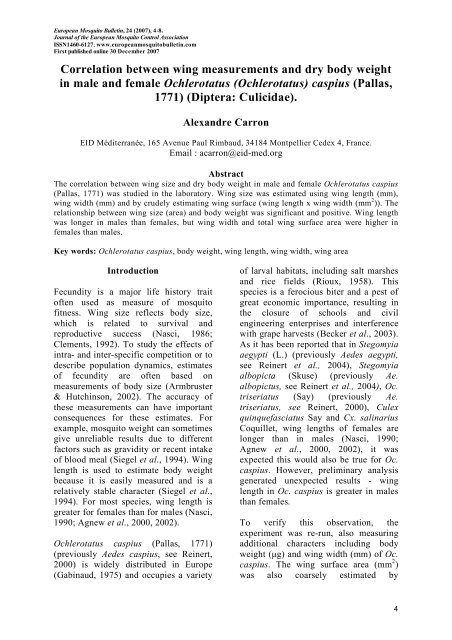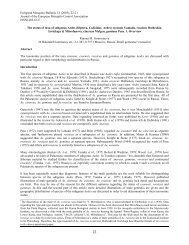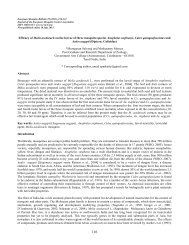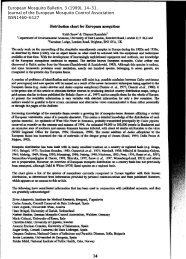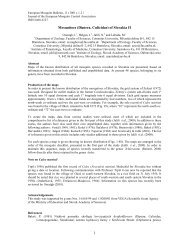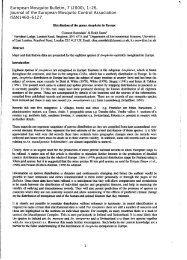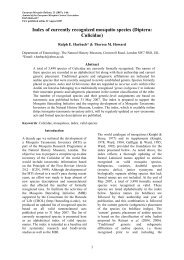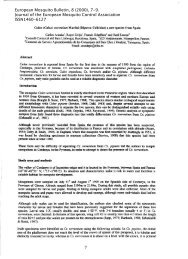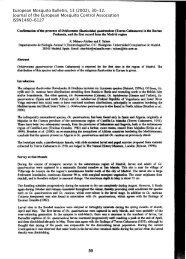Correlation between wing measurements and dry body weight in ...
Correlation between wing measurements and dry body weight in ...
Correlation between wing measurements and dry body weight in ...
You also want an ePaper? Increase the reach of your titles
YUMPU automatically turns print PDFs into web optimized ePapers that Google loves.
European Mosquito Bullet<strong>in</strong>, 24 (2007), 4-8.Journal of the European Mosquito Control AssociationISSN1460-6127; www.europeanmosquitobullet<strong>in</strong>.comFirst published onl<strong>in</strong>e 30 December 2007<strong>Correlation</strong> <strong>between</strong> <strong>w<strong>in</strong>g</strong> <strong>measurements</strong> <strong>and</strong> <strong>dry</strong> <strong>body</strong> <strong>weight</strong><strong>in</strong> male <strong>and</strong> female Ochlerotatus (Ochlerotatus) caspius (Pallas,1771) (Diptera: Culicidae).Alex<strong>and</strong>re CarronEID Méditerranée, 165 Avenue Paul Rimbaud, 34184 Montpellier Cedex 4, France.Email : acarron@eid-med.orgAbstractThe correlation <strong>between</strong> <strong>w<strong>in</strong>g</strong> size <strong>and</strong> <strong>dry</strong> <strong>body</strong> <strong>weight</strong> <strong>in</strong> male <strong>and</strong> female Ochlerotatus caspius(Pallas, 1771) was studied <strong>in</strong> the laboratory. W<strong>in</strong>g size was estimated us<strong>in</strong>g <strong>w<strong>in</strong>g</strong> length (mm),<strong>w<strong>in</strong>g</strong> width (mm) <strong>and</strong> by crudely estimat<strong>in</strong>g <strong>w<strong>in</strong>g</strong> surface (<strong>w<strong>in</strong>g</strong> length x <strong>w<strong>in</strong>g</strong> width (mm 2 )). Therelationship <strong>between</strong> <strong>w<strong>in</strong>g</strong> size (area) <strong>and</strong> <strong>body</strong> <strong>weight</strong> was significant <strong>and</strong> positive. W<strong>in</strong>g lengthwas longer <strong>in</strong> males than females, but <strong>w<strong>in</strong>g</strong> width <strong>and</strong> total <strong>w<strong>in</strong>g</strong> surface area were higher <strong>in</strong>females than males.Key words: Ochlerotatus caspius, <strong>body</strong> <strong>weight</strong>, <strong>w<strong>in</strong>g</strong> length, <strong>w<strong>in</strong>g</strong> width, <strong>w<strong>in</strong>g</strong> areaIntroductionFecundity is a major life history traitoften used as measure of mosquitofitness. W<strong>in</strong>g size reflects <strong>body</strong> size,which is related to survival <strong>and</strong>reproductive success (Nasci, 1986;Clements, 1992). To study the effects of<strong>in</strong>tra- <strong>and</strong> <strong>in</strong>ter-specific competition or todescribe population dynamics, estimatesof fecundity are often based on<strong>measurements</strong> of <strong>body</strong> size (Armbruster& Hutch<strong>in</strong>son, 2002). The accuracy ofthese <strong>measurements</strong> can have importantconsequences for these estimates. Forexample, mosquito <strong>weight</strong> can sometimesgive unreliable results due to differentfactors such as gravidity or recent <strong>in</strong>takeof blood meal (Siegel et al., 1994). W<strong>in</strong>glength is used to estimate <strong>body</strong> <strong>weight</strong>because it is easily measured <strong>and</strong> is arelatively stable character (Siegel et al.,1994). For most species, <strong>w<strong>in</strong>g</strong> length isgreater for females than for males (Nasci,1990; Agnew et al., 2000, 2002).Ochlerotatus caspius (Pallas, 1771)(previously Aedes caspius, see Re<strong>in</strong>ert,2000) is widely distributed <strong>in</strong> Europe(Gab<strong>in</strong>aud, 1975) <strong>and</strong> occupies a varietyof larval habitats, <strong>in</strong>clud<strong>in</strong>g salt marshes<strong>and</strong> rice fields (Rioux, 1958). Thisspecies is a ferocious biter <strong>and</strong> a pest ofgreat economic importance, result<strong>in</strong>g <strong>in</strong>the closure of schools <strong>and</strong> civileng<strong>in</strong>eer<strong>in</strong>g enterprises <strong>and</strong> <strong>in</strong>terferencewith grape harvests (Becker et al., 2003).As it has been reported that <strong>in</strong> Stegomyiaaegypti (L.) (previously Aedes aegypti,see Re<strong>in</strong>ert et al., 2004), Stegomyiaalbopicta (Skuse) (previously Ae.albopictus, see Re<strong>in</strong>ert et al., 2004), Oc.triseriatus (Say) (previously Ae.triseriatus, see Re<strong>in</strong>ert, 2000), Culexqu<strong>in</strong>quefasciatus Say <strong>and</strong> Cx. sal<strong>in</strong>ariusCoquillet, <strong>w<strong>in</strong>g</strong> lengths of females arelonger than <strong>in</strong> males (Nasci, 1990;Agnew et al., 2000, 2002), it wasexpected this would also be true for Oc.caspius. However, prelim<strong>in</strong>ary analysisgenerated unexpected results - <strong>w<strong>in</strong>g</strong>length <strong>in</strong> Oc. caspius is greater <strong>in</strong> malesthan females.To verify this observation, theexperiment was re-run, also measur<strong>in</strong>gadditional characters <strong>in</strong>clud<strong>in</strong>g <strong>body</strong><strong>weight</strong> (µg) <strong>and</strong> <strong>w<strong>in</strong>g</strong> width (mm) of Oc.caspius. The <strong>w<strong>in</strong>g</strong> surface area (mm 2 )was also coarsely estimated by4
W<strong>in</strong>g size <strong>and</strong> <strong>body</strong> <strong>weight</strong> <strong>in</strong> Oc. caspiusA. CarronW<strong>in</strong>g characters r² Source Estimate t-valueW<strong>in</strong>g length 0.77 Intercept female 1.846 19.914***Intercept male 2.067 10.539***Slope (<strong>body</strong> <strong>weight</strong>) 0.0018 7.879***Interaction (sex: <strong>body</strong> <strong>weight</strong>) NA 3.409 ns aW<strong>in</strong>g width 0.89 Intercept female 0.609 15.859***Intercept male 0.503 12.245***Slope (<strong>body</strong> <strong>weight</strong>) 0.0005 5.858***Interaction (sex: <strong>body</strong> <strong>weight</strong>) NA 0.414 ns aW<strong>in</strong>g surface area 0.76 Intercept female 1.004 7.077***Intercept male 0.891 -3.518**Slope (<strong>body</strong> <strong>weight</strong>) 0.0029 8.072***Interaction (sex: <strong>body</strong> <strong>weight</strong>) NA 0.039 ns aTable 1: ANCOVA results of the relationship of <strong>w<strong>in</strong>g</strong> <strong>measurements</strong> (<strong>w<strong>in</strong>g</strong> length, <strong>w<strong>in</strong>g</strong> width <strong>and</strong> <strong>w<strong>in</strong>g</strong>surface (length x width) as a function of <strong>body</strong> <strong>weight</strong> <strong>and</strong> sex. ns (p > 0.05); *(p < 0.05); **(p < 0.01);***(p < 0.001). a F-value of the <strong>in</strong>teractions was calculated us<strong>in</strong>g ANCOVA.multiply<strong>in</strong>g the <strong>w<strong>in</strong>g</strong> length <strong>and</strong> the <strong>w<strong>in</strong>g</strong>width. Regressions <strong>between</strong> these three<strong>w<strong>in</strong>g</strong> characters <strong>and</strong> <strong>body</strong> <strong>weight</strong> for bothmales <strong>and</strong> females were calculated <strong>and</strong>compared.Materials <strong>and</strong> methodsDur<strong>in</strong>g the summer of 2006, soil sampleswere collected from a known Oc. caspiusbreed<strong>in</strong>g site <strong>in</strong> the Rhône delta <strong>in</strong>southern France to obta<strong>in</strong> eggs forrear<strong>in</strong>g <strong>in</strong> the laboratory. Sampl<strong>in</strong>g wascarried out us<strong>in</strong>g vegetation as an<strong>in</strong>dicator of egg biotopes (Gab<strong>in</strong>aud,1975). Ascorbic acid was used to <strong>in</strong>itiateegg hatch<strong>in</strong>g (S<strong>in</strong>ègre, 1974) <strong>and</strong> larvaewere reared to adult stage <strong>in</strong> thelaboratory at 28.4 ± 0.3°C, 52 ± 0.7% RH<strong>and</strong> 16:8 L:D.One day after emergence, 20 unfed adultsof each sex were killed, transferred to<strong>in</strong>dividual 1.5 ml plastic vials, dried at60°C for at least 12 h, <strong>and</strong> weighed to aprecision of ± 1 µg us<strong>in</strong>g a MettlerToledo MX5 balance (Mettler-ToledoGmbH, Greifensee, Switzerl<strong>and</strong>).Subsequently, the left <strong>w<strong>in</strong>g</strong> wasremoved, <strong>and</strong> its length (from the axillary<strong>in</strong>cision to the <strong>w<strong>in</strong>g</strong> tip) <strong>and</strong> maximumwidth were measured us<strong>in</strong>g astereomicroscope (Zeiss Stemi 2000C)coupled with the measurement softwareEllix TM (Microvision <strong>in</strong>struments,France). The normality of the <strong>body</strong><strong>weight</strong>, <strong>w<strong>in</strong>g</strong> length, <strong>w<strong>in</strong>g</strong> width <strong>and</strong><strong>w<strong>in</strong>g</strong> surface (length x width) were testedus<strong>in</strong>g the Shapiro-Wilk test (Zar, 1999).Analysis of covariance (ANCOVA) (Zar,1999) was used to assess the regression<strong>between</strong> <strong>body</strong> <strong>weight</strong> <strong>and</strong> each <strong>w<strong>in</strong>g</strong>measurement accord<strong>in</strong>g to sex. Male <strong>and</strong>female <strong>body</strong> sizes were compared with at-Test (Zar, 1999). All statistical analyseswere done us<strong>in</strong>g R 2.4.0 software (RDevelopment Core Team, 2005).Results <strong>and</strong> DiscussionBody <strong>weight</strong>, <strong>w<strong>in</strong>g</strong> length, <strong>w<strong>in</strong>g</strong> width<strong>and</strong> <strong>w<strong>in</strong>g</strong> surface were normallydistributed (Shapiro-Wilk test, n = 40,p = 0.158, 0.771, 0.157, 0.692,respectively). The slopes of theregression for <strong>body</strong> <strong>weight</strong> <strong>and</strong> each<strong>w<strong>in</strong>g</strong> measurement (length, width <strong>and</strong>area) were all significant <strong>and</strong> positive(ANCOVA, p < 0.01; Table 1, Figure 1ac).Moreover, as the <strong>in</strong>teractions <strong>between</strong>sex <strong>and</strong> <strong>body</strong> <strong>weight</strong> were not significant,the slopes <strong>between</strong> males <strong>and</strong> femaleswere not significantly different. Hence,an <strong>in</strong>crease <strong>in</strong> <strong>w<strong>in</strong>g</strong> size denoted anequivalent <strong>in</strong>crease <strong>in</strong> <strong>body</strong> <strong>weight</strong> <strong>in</strong>males <strong>and</strong> females.5
European Mosquito Bullet<strong>in</strong>, 24 (2007), 4-8.Journal of the European Mosquito Control AssociationISSN1460-6127; www.europeanmosquitobullet<strong>in</strong>.comFirst published onl<strong>in</strong>e 30 December 2007(a)(b)(c)The <strong>in</strong>tercepts of <strong>w<strong>in</strong>g</strong> length, <strong>w<strong>in</strong>g</strong>width <strong>and</strong> <strong>w<strong>in</strong>g</strong> surface area <strong>in</strong> Oc.caspius were different <strong>between</strong> the sexes(Table 1). The <strong>w<strong>in</strong>g</strong> length <strong>in</strong>tercept wassignificantly higher for males than forfemales (Figure 1a). Therefore for thesame <strong>body</strong> <strong>weight</strong>, the <strong>w<strong>in</strong>g</strong> length ofmale Oc. caspius is greater than forfemales. The <strong>in</strong>tercepts of <strong>w<strong>in</strong>g</strong> width<strong>and</strong> <strong>w<strong>in</strong>g</strong> surface were significantlyhigher for females than for males (Table1). Therefore for the same <strong>body</strong> <strong>weight</strong>,the <strong>w<strong>in</strong>g</strong> width (Figure 1b) wassignificantly larger for females than thatfor males, <strong>and</strong> female <strong>w<strong>in</strong>g</strong> surface wassignificantly greater than for males(Figure 1c).Nasci (1990) noted that the slopes of theregression <strong>between</strong> <strong>w<strong>in</strong>g</strong> length <strong>and</strong> <strong>body</strong><strong>weight</strong> were significantly different<strong>between</strong> the two sexes for three mosquitospecies reared <strong>in</strong> the laboratory (St.aegypti, St. albopictus, <strong>and</strong> Cx.qu<strong>in</strong>quefasciatus) <strong>and</strong> for five speciescollected <strong>in</strong> the field (St. aegypti, St.albopictus, Oc. triseriatus, Culexqu<strong>in</strong>quefasciatus, Cx. sal<strong>in</strong>arius). Resultspresented here for Oc. caspius weredifferent, <strong>and</strong> suggest that <strong>w<strong>in</strong>g</strong> length isnot always greater <strong>in</strong> females. Althoughthe relatively low replicates (n=40) used<strong>in</strong> this experiment could be criticized, thehigh r² of the ANCOVA suggests thatregression values will probably not bealtered by <strong>in</strong>creas<strong>in</strong>g the number ofreplicates, thus use of <strong>w<strong>in</strong>g</strong> length aloneto estimate <strong>body</strong> size should be used withcaution <strong>in</strong> previously unstudied speciesFigure 1: Regression of <strong>w<strong>in</strong>g</strong> <strong>measurements</strong> as afunction of <strong>dry</strong> <strong>body</strong> <strong>weight</strong> (µg) for males(triangle, dashed l<strong>in</strong>e) <strong>and</strong> females (circle, solidstraight l<strong>in</strong>e); a) <strong>w<strong>in</strong>g</strong> length (mm), b) <strong>w<strong>in</strong>g</strong>width (mm), c) <strong>w<strong>in</strong>g</strong> surface (<strong>w<strong>in</strong>g</strong> length x <strong>w<strong>in</strong>g</strong>width) (mm 2 ). Regressions presented <strong>in</strong> eachfigure were calculated for each sex separately.W<strong>in</strong>g surface area was greater <strong>in</strong> femaleOc. caspius than <strong>in</strong> males, but theconverse was true for <strong>w<strong>in</strong>g</strong> length <strong>in</strong>contrast to previous studies (Nasci, 1990;Agnew et al., 2000, 2002). As the <strong>body</strong><strong>weight</strong> of the females were significantlyhigher than the males (t-Test, p < 0.01),these results suggest that us<strong>in</strong>g <strong>w<strong>in</strong>g</strong>length alone to estimate <strong>body</strong> size, may6
W<strong>in</strong>g size <strong>and</strong> <strong>body</strong> <strong>weight</strong> <strong>in</strong> Oc. caspiusA. Carrongive unreliable results. The results here<strong>in</strong>suggest that even a crude estimate of<strong>w<strong>in</strong>g</strong> surface area is a better estimate of<strong>body</strong> size than <strong>w<strong>in</strong>g</strong> length alone,perhaps because the former gives a betterpicture of <strong>w<strong>in</strong>g</strong> lift. When compar<strong>in</strong>g<strong>in</strong>tra-sex or <strong>in</strong>tra-species, the <strong>w<strong>in</strong>g</strong> lengthmay appear reliable, but this study showsthat changes <strong>in</strong> <strong>w<strong>in</strong>g</strong> shape <strong>between</strong>sexes or species mean that <strong>w<strong>in</strong>g</strong> lift (<strong>and</strong>therefore maximum <strong>body</strong> size) may arebetter estimated by us<strong>in</strong>g surface area.AcknowledgementsI appreciate the collaboration of DrPhilip Agnew for his help <strong>in</strong> establish<strong>in</strong>gthis study <strong>and</strong> for the help <strong>in</strong> revis<strong>in</strong>g themanuscript. I also thank Pr J.-A. Rioux,Dr J. Cousserans, Dr G. Duvallet, Dr J.-P. Hervé <strong>and</strong> C. Lagneau for their criticalreview of the manuscript. We are gratefulto O. Moussiegt for help <strong>in</strong> translation<strong>and</strong> correction of the manuscript.ReferencesAgnew, P., Haussy, C. & Michalakis, Y.(2000) Effects of density <strong>and</strong>larval competition on selectedlife history traits of Culexpipiens qu<strong>in</strong>quefasciatus(Diptera: Culicidae). Journal ofMedical Entomology, 37(5),732-735.Agnew, P., Hide, M., Sidobre, C. &Michalakis, Y. (2002) Am<strong>in</strong>imalist approach to theeffects of density-dependentcompetition on <strong>in</strong>sect lifehistorytraits. EcologicalEntomology, 27, 396-402.Armbruster, P. & Hutch<strong>in</strong>son, R. (2002)Pupal mass <strong>and</strong> <strong>w<strong>in</strong>g</strong> length as<strong>in</strong>dicators of fecundity <strong>in</strong> Aedesalbopictus <strong>and</strong> Aedesgeniculatus (Diptera: Culicidae).Journal of Medical Entomology,39(4), 699-704.Becker, N., Petric, D., Zgomba, M.,Boase, C., Dahl, C., Lane, J. &Kaiser, A. (2003) Mosquitoes<strong>and</strong> their control. KluwerAcademic / Plenum Publishers.498pp.Clements, A. (1992) The biology ofmosquitoes. Volume 1Development, nutrition <strong>and</strong>reproduction. Chapman & Hall.509pp.Gab<strong>in</strong>aud, A. (1975) Ecologie de deuxAedes halophiles du littoralméditerranéen français Aedes(Ochlerotatus) caspius (Pallas,1771) Aedes (Ochlerotatus)detritus (Haliday, 1833)(Nematocera - Culicidae).Utilisation de la végétationcomme <strong>in</strong>dicateur biotique pourl'établissement d'une carteécologique. Application endynamique des populations. PhDdissertation, Montpellier,Université des Sciences etTechniques du Languedoc,465pp.Nasci, R. (1986) The size of emerg<strong>in</strong>g<strong>and</strong> host-seek<strong>in</strong>g Aedes aegypti<strong>and</strong> the relation of size to bloodfeed<strong>in</strong>gsuccess <strong>in</strong> the field.Journal of the AmericanMosquito Control Association,2(1), 61-62.Nasci, R. (1990) Relationship of <strong>w<strong>in</strong>g</strong>length to adult <strong>dry</strong> <strong>weight</strong> <strong>in</strong>several mosquito species(Diptera: Culicidae). Journal ofMedical Entomology 27(4), 716-719.Re<strong>in</strong>ert, J. (2000) New classification forthe composite genus Aedes(Diptera: Culicidae: Aed<strong>in</strong>i),elevation of subgenusOchlerotatus to generic rank,reclassification of the othersubgenera, <strong>and</strong> notes on certa<strong>in</strong>subgenera <strong>and</strong> species. Journalof the American Mosquito7
European Mosquito Bullet<strong>in</strong>, 24 (2007), 4-8.Journal of the European Mosquito Control AssociationISSN1460-6127; www.europeanmosquitobullet<strong>in</strong>.comFirst published onl<strong>in</strong>e 30 December 2007Control Association 16(3), 175-188Re<strong>in</strong>ert, J.F., Harbach, R.E. & Kitch<strong>in</strong>g,I.J. 2004. Phylogeny <strong>and</strong>classification of Aed<strong>in</strong>i (Diptera:Culicidae) based on morphologicalcharacters of all life stages.Zoological Journal of the L<strong>in</strong>neanSociety, 142, 289-368.Rioux, J.-A. (1958). Les culicides du"midi" méditerranéen.Encyclopédie Entomologique.Editions Paul Lechevalier.303pp.Siegel, J., Novak, R. & Rues<strong>in</strong>k, W.(1994) Relationship <strong>between</strong><strong>w<strong>in</strong>g</strong> length <strong>and</strong> <strong>dry</strong> <strong>weight</strong> ofmosquitoes. Journal of theAmerican Mosquito ControlAssociation 10(2), 186-196.S<strong>in</strong>ègre, G. (1974). Contribution à l'étudephysiologique d'Aedes(Ochlerotatus) caspius (Pallas,1771) (Nematocera - Culicidae).Eclosion - Dormance -Développement - Fertilité. PhDdissertation, Montpellier,Université des Sciences etTechniques du Languedoc,285pp.R Development Core Team (2005) R: Alanguage <strong>and</strong> environment forstatistical comput<strong>in</strong>g. Vienna,Austria, R Foundation forStatistical Comput<strong>in</strong>g. www.rproject.orgZar, J. (1999) Biostatistical analysis.Prentice Hall. 663pp.8


